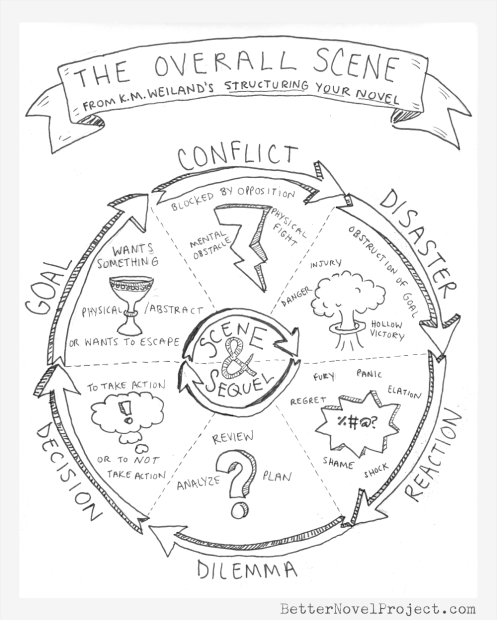Hey there!
Welcome back to the Zero to Book series!
In our last post, we used AI to expand the 15 Save The Cat story beats into a detailed 40-50 scene outline. Today, we will zoom in and focus on structuring your scenes to keep your reader flipping pages. Because even with a solid outline, the reader may close the book if your scenes are shaky.
When you craft scenes that hum with tension and purpose, you create a story that readers can't put down.
Great scenes:
Create a sense of momentum and narrative drive
Keep readers engrossed and emotionally invested
Provide payoffs propelling toward the larger story goal
So, how do you write a great scene?
It starts with understanding their fundamental structure.
The Shape Of A Scene
A novel is like an inverted triangle.
It starts off wide at the beginning, giving readers a lay of the land. Then as the story progresses, that triangle narrows, squeezing and pressuring the characters and propelling them (and the reader) inevitably toward the point of the triangle—the climax.
Take Gone Girl by Gillian Flynn, for example.
The book opens by painting a picture of Nick and Amy Dunne's troubled marriage. Then when Amy goes missing, the walls start closing in around Nick as suspicion mounts and clues point to his involvement. The scenes get tighter and more tense as the triangle narrows toward the shocking reveal.
This inverted triangle structure applies at both a macro story level and a micro scene level. Because each scene is like a mini-story, with its own arc.
Let’s break it down.
The Scene-Sequel Pattern
In his book "The Snowflake Method", author Randy Ingermanson argues that at a fundamental level, all stories are made up of an alternating pattern of two elements he calls "Scenes" and "Sequels".
Let's start with Scenes.
The Scene
Ingermanson suggests that a Scene plays out in a three-part structure:
The character pursues a Goal
The character faces Conflict
The character meets with a Disaster that keeps them from the goal and raises the stakes
For example, in a romance, our heroine Nina has the goal of securing a big client to save her struggling business (Goal). She faces fierce competition from a rival firm (Conflict). But just as she's about to clinch the deal, her ex-boyfriend walks in—as a representative of the rival firm (Disaster).
This pattern of Goal, Conflict, and Disaster is the heartbeat of a compelling scene.
The Goal gives the character (and thus the reader) something to root for. The Conflict creates tension and uncertainty. And the Disaster leaves the character worse off than they started, raising the stakes and pushing the story forward.
But a story can't be all action and escalating disaster.
That's where the Sequel comes in.
The Sequel
After the Disaster, the character needs a moment to catch their breath - and so does the reader. That's the function of a Sequel.
Ingermanson breaks down the Sequel into three parts:
The character Reacts emotionally to the Disaster
The character faces a Dilemma with no good options
The character makes a Decision that sets up a new Goal
Back to our romance example: After the disastrous meeting, Nina reacts with a mix of anger, humiliation, and despair (Reaction). She feels torn between wanting to win the client to prove herself, and wanting to avoid her ex at all costs (Dilemma). Finally, she decides she won't let her past control her and vows to beat her ex fair and square (Decision)—setting up a new Goal for the next Scene.
This Reaction-Dilemma-Decision arc is crucial for pacing and reader engagement. It allows the character (and the reader) to process the Disaster, and it sets up the next Goal, propelling us into the next Scene.
This alternating Scene-Sequel structure also maps neatly onto the inverted triangle.
In each Scene, the character's pursuit of their Goal is like the widest part of the triangle. As Conflict mounts, the walls close in, until the Disaster leaves them with a narrow set of options - represented by the Dilemma phase of the Sequel. Then, the Dilemma forces the character to make a Decision, the point of the triangle, which focuses them on a new Goal and kicks off the next Scene's inverted triangle.
By stacking these Scene-Sequel cycles back-to-back, you create a chain of ever-tightening tension that propels the character (and the reader) through the story, all the way to the ultimate crisis and resolution.
Now that we understand the structure and function of Scenes and Sequels, let's look at how we can use AI to help us write them.
Write Your Scenes And Sequels With AI
In our last post, we helped you write a scene description for each point in your outline.
Now, we are going to expand on each scene. For example, let's say we're writing a fantasy novel and mapping out a scene with the beat "Sasha outwits the Duke's guards."
Our scene description might look like this:
Goal: Sasha wants to sneak into the castle to find an important clue
Conflict: The castle is heavily guarded, with patrols and magical wards blocking her path
Disaster: Sasha manages to get inside using a disguise but accidentally alerts a guard, who sounds the alarm and forces her to flee without the clue
Knowing your scene's Goal, Conflict, and Disaster gives you guidelines to write within.
Let’s write.
Step 1: Write Your Scene
Take your scene description and ask AI to expand it into a full scene:
Keep reading with a 7-day free trial
Subscribe to Fiction Writing With AI to keep reading this post and get 7 days of free access to the full post archives.





